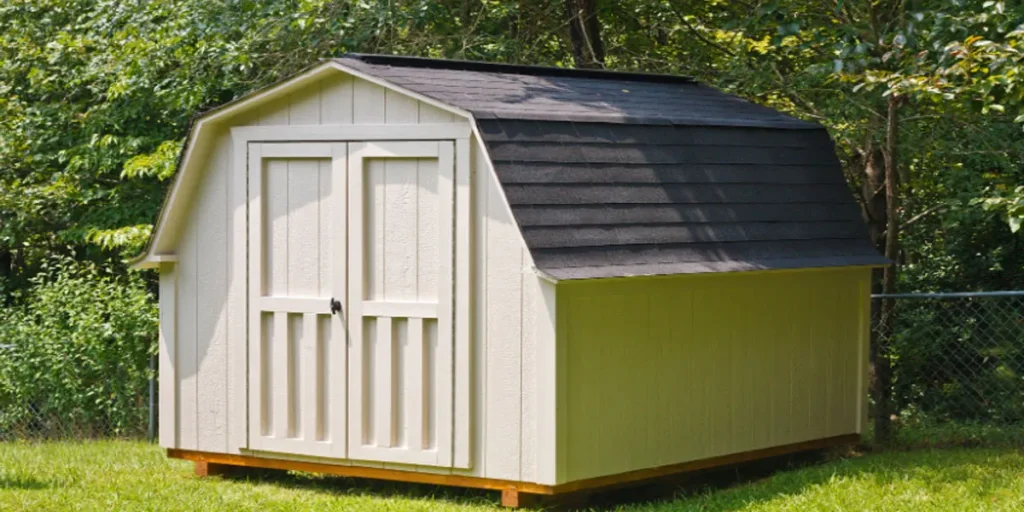The weight of a shed varies, typically ranging from 100 to 5,000 pounds or more. Factors include size, materials, and construction.
Selecting the ideal shed for your backyard or business property requires an understanding of its impact on your space.
Durability, functionality, and the ability to withstand environmental conditions are pivotal when considering a shed.
Plastic, wood, and metal are common materials used in shed construction, each contributing differently to the total weight.
Small garden sheds may weigh as little as 100 pounds, while larger, more robust structures designed for heavy equipment or extensive storage can exceed 5,000 pounds.
Before installation, assessing the ground support and foundation requirement is essential to ensure the chosen shed will be supported adequately.
The weight of your shed will also influence transportation costs and assembly methods, making this information crucial from the get-go.
Shed Basics And Measurements
Understanding the size and weight of your shed is vital. Different sheds serve diverse purposes and fit into various spaces.
Each shed’s dimensions and materials impact its weight significantly. Knowing these details helps determine the best spot in your yard and how to prepare for the installation.
Typical Shed Dimensions
Selecting the right shed involves knowing standard sizes. These are:
- Small: Usually 6’x4′ or 8’x6′ for minimal storage
- Medium: Often 10’x8′ or 10’x12′, balancing size and space
- Large: Can reach 12’x20′ and above for extensive use
Each size has a typical height of 7 to 9 feet, providing ample headroom. Size impacts weight, so it’s essential to match the shed’s dimensions with its intended purpose and available space.
Material Considerations
Materials determine a shed’s weight and durability. Common materials include:
| Material | Weight |
|---|---|
| Wood | Heaviest, varies with size |
| Metal | Lighter than wood, depends on gauge |
| Plastic | Lightest, consistent across sizes |
Remember, the foundation must support the shed’s weight. Ensure the ground preparation reflects the material choice and shed dimensions for a stable and lasting setup.
Weight Factors For Different Shed Types

Understanding how much a shed weighs is essential before installation. Shed weight depends on the material, size, and design. Here, we explore different shed types and their weight factors.
Metal Sheds
Metal sheds offer durability with relatively light weight. Constructed from materials like aluminum or steel, they vary in weight:
- Small metal sheds (around 6’x8′): can weigh from 70 to 200 pounds.
- Larger units (10’x12′ or more): can weigh upwards of 300 to 500 pounds.
Steel sheds are heavier than aluminum but provide added strength. They may require a foundation due to the weight.
Wooden Sheds
Wooden sheds bring a classic look but also more weight. Factors such as wood type and thickness contribute to this:
| Shed Size | Approximate Weight |
|---|---|
| Small (6’x8′) | 800 pounds to 1000 pounds |
| Medium (8’x10′) | 1,200 pounds to 2,500 pounds |
| Large (10’x12′ upwards) | 2,500 pounds to 5,000 pounds |
Pressure-treated wood adds to the weight but is necessary for outdoor durability.
Plastic And Resin Sheds
Plastic and resin sheds are popular for being lightweight and maintenance-free. They are ideal for small spaces and light storage.
- A small plastic shed can be as light as 50 pounds.
- Larger models (10’x12′) may range between 200 to 400 pounds.
Resin sheds resist weather and are easier to move due to their lesser weight.
Calculating Shed Weight

Knowing your shed’s weight is vital for safety, transportation, and building permits. Before you can move or build a shed, you must calculate how heavy it is.
The weight depends on its materials and size. Let’s break down how to calculate the weight of your shed.
Floor Weight Calculations
The floor is the foundation of your shed. It supports everything inside. To calculate the floor weight, consider the following:
- Material: Wood, concrete, or metal?
- Thickness: Thicker floors weigh more.
- Area: Multiply length by width for square footage.
Use weight per square foot figures for your material:
| Material | Weight/Sq Ft |
|---|---|
| Wood | 3-4 lbs |
| Concrete | 12-18 lbs |
| Metal | 5-10 lbs |
Multiply area by weight/sq ft to get the total floor weight.
Wall And Roof Weight Estimates
Walls and the roof form the upper structure of the shed. Their weight comes from wood, siding, and roofing materials. To estimate wall and roof weight, use these steps:
- Determine the wall’s total square footage.
- Add the square footage of the roof.
- Refer to typical material weights:
| Material | Weight/Sq Ft |
|---|---|
| Wood Siding | 2-3 lbs |
| Asphalt Shingles | 2-4 lbs |
| Metal Panels | 1-3 lbs |
For each wall and the roof, multiply the total square footage by the weight/sq ft. Then, add them up for the shed’s total weight.
Impact Of Shed Foundations On Weight
Understanding how foundations affect a shed’s weight is essential.
The right foundation ensures stability and durability.
Different materials impact the overall weight differently.
Concrete Slabs
Concrete slabs provide a sturdy base for sheds.
- Increases weight significantly.
- Durable against weather changes.
- Can handle heavy-duty sheds.
These slabs can add hundreds of pounds.
Wooden Foundations
Wooden foundations are popular for lighter structures.
- Less weight gain than concrete.
- Offers flexibility and ease of construction.
- Suitable for small to medium sheds.
Wooden options vary in weight by type and size.
Gravel Bases
Gravel bases are a lightweight alternative.
- Improves drainage around the shed.
- Easy to install and adjust.
- Minimal weight increase.
This choice is great for smaller sheds.
| Foundation Type | Weight Impact | Best For |
|---|---|---|
| Concrete | High | Large, Heavy-Duty Sheds |
| Wood | Medium | Small to Medium Sheds |
| Gravel | Low | Light, Portable Sheds |
Transporting And Installing Sheds
Sheds vary in weight and size, making transporting and installing a crucial step. Moving them can be a challenge.
Right techniques ensure your shed arrives safely and in perfect condition at your home or business. Let’s explore options for moving and assembling sheds.
Moving A Pre-built Shed
Finding the right method to move a pre-built shed matters. Weight and dimensions dictate the best approach.
Professional movers often use specialized equipment. They can haul sheds intact to new locations. Below, you’ll find common tools and considerations for moving a pre-built shed:
- Trailer: Attach to a truck for easy transportation.
- Forklift: For local moves, works well on solid surfaces.
- Crane: Lifts shed over obstacles, suitable for heavy and large sheds.
- Rollers or skids: Slide shed across the ground to the new location.
Always check for local permits needed. Tie-downs and wide load signs might be required. Insurance is another important consideration.
On-site Shed Assembly
Assembling a shed on-site is a popular option. It is great for places hard to reach. It also lets owners customize their shed’s position. Here’s a breakdown of on-site assembly steps:
- Select a level foundation spot.
- Gather all necessary tools and materials.
- Follow the manufacturer’s instructions carefully.
- Secure each piece together tightly.
- Install doors, windows, and roofing last.
Teams can build smaller sheds in a day. Larger or more complex designs might take longer. Properly assembled sheds last longer and remain sturdy over time.
Maintaining Your Shed’s Condition And Stability
Knowing the weight of your shed is crucial. It helps ensure it stays safe and secure. Yet, weight is just one factor.
Regular upkeep keeps your shed in tip-top shape. Let’s dive into maintaining your shed’s health.
Routine Maintenance Tips
Consistent care prevents issues and extends your shed’s life. Follow these steps:
- Inspect your shed often. Look for cracks or rust.
- Clean the interior and exterior regularly.
- Check the roof for leaks or damage.
- Ensure that doors and windows close properly.
- Apply paint or sealant to protect from weather.
- Treat wooden sheds to prevent rot.
Addressing Weight-related Issues
Heavy sheds need solid foundations. Weight-related problems can impact stability. Steps to address these:
- Determine the total weight your shed can safely handle.
- Monitor for signs of ground sinking or frame warping.
- Store items evenly to distribute weight.
- If excess weight is an issue, remove items or reinforce the structure.
- Contact professionals if major issues arise.
FAQ About the Weight of a Shed
What Factors Influence A Shed’s Weight?
Several elements determine a shed’s weight, including its size, materials used (wood, metal, plastic), and any additional features or reinforcements.
Larger sheds or those made from heavier materials such as wood will weigh more.
How Do Materials Affect Shed Weight?
Material choice has a significant impact on shed weight. Wooden sheds are typically heavier than metal or plastic ones.
Durability and support structures also contribute to the overall weight differences among shed materials.
Can Shed Weight Affect Installation Requirements?
Yes, a shed’s weight can influence installation demands.
Heavier sheds may require a more stable foundation, sometimes extending to concrete or reinforced bases, to prevent sinking or structural issues over time.
What Is The Average Weight Of A Garden Shed?
The average weight of a garden shed varies but generally ranges from 300 to 600 pounds for smaller structures and can exceed 2,500 pounds for larger, more robust models or those with additional features.
Conclusion
Understanding your shed’s weight is crucial for transportation, installation, and safety. The factors influencing this number are varied, from materials to size.
Always consult product specifications or experts for accurate measurements. Proper knowledge ensures seamless integration into your space, affirming its functionality and longevity.
Resources:
https://www.nyc.gov/site/buildings/property-or-business-owner/fences-backyard-sheds.page
